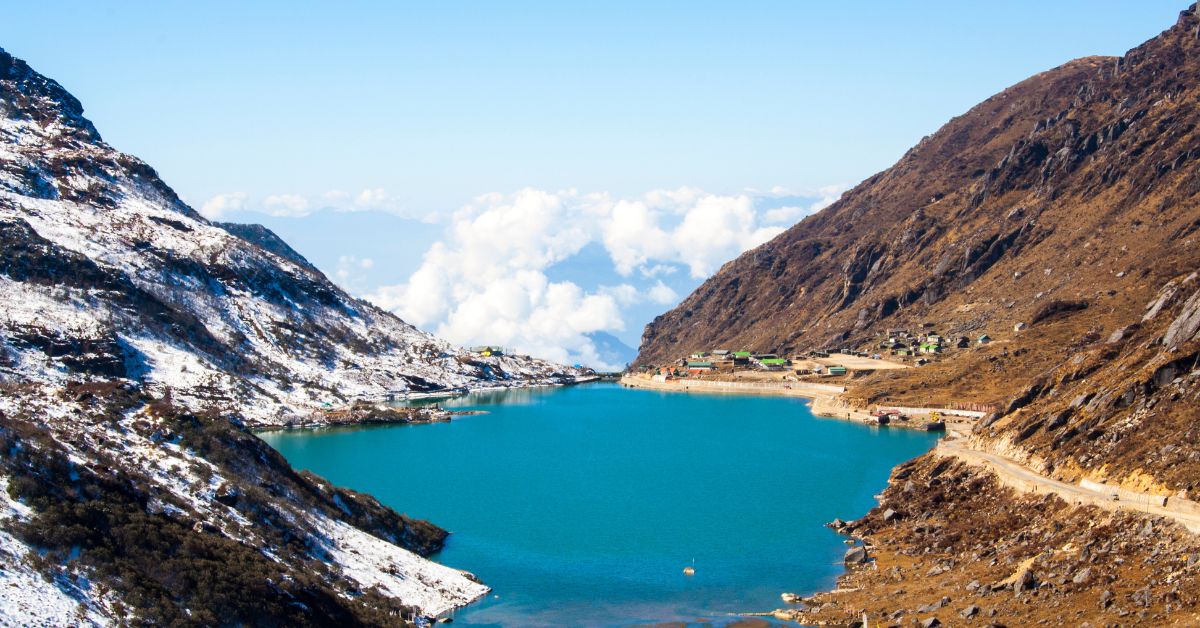Carved by glaciers at an altitude of 3,753 meters in the majestic Eastern Himalayas, Tsomgo Lake shimmers like a jewel amidst snow-capped peaks. This breathtaking glacial escape isn’t just a feast for the eyes; it’s a haven for nature lovers and adventure enthusiasts. Nestled just 40 kilometers from Sikkim’s capital, Gangtok, Tsomgo Lake offers a tranquil escape from the urban clamor.
The very name “Tsomgo,” which translates to “Source of Water” in the Bhutia language, hints at the lake’s significance as the lifeblood of the region’s ecosystem. The crystal-clear waters of Tsomgo Lake transform throughout the seasons, reflecting a kaleidoscope of colors that leave visitors spellbound. Local legends weave a tapestry of intrigue around the lake, adding another layer to its charm.
How to reach:
Taking Flight:
Your aerial gateway to Tsomgo Lake is Pakyong Airport, situated roughly 35 kilometers from Gangtok. However, due to limited flight options, many travelers opt for Bagdogra Airport in West Bengal, which is approximately 124 kilometers away. From either airport, taxis and shared cabs are readily available to whisk you to Gangtok.
Train Travel:
For a scenic journey, consider the train route. The closest railway station is New Jalpaiguri Junction (NJP) in Siliguri, West Bengal, about 148 kilometers from Gangtok. Taxis and shared cabs are easily found at NJP to take you to Gangtok, offering glimpses of verdant hills and winding roads along the way.
Road Trip:
Tsomgo Lake lies approximately 40 kilometers from Gangtok, easily accessible by road. The most popular option is to hire a taxi or book a shared vehicle from Gangtok. The journey takes roughly 2 hours and rewards you with breathtaking vistas of the mountainous landscape and charming local scenery.
Best time to visit:
Spring and Summer (April to June):
Tsomgo Lake bursts into vibrant life during spring and summer. With comfortable temperatures between 10°C and 20°C, it’s an ideal time to explore the outdoors. Lush greenery paints the mountains and valleys, contrasting beautifully with clear blue skies. Visitors can partake in sightseeing, take scenic yak rides, and witness the enchanting blooms of rhododendrons and primulas that enhance the magical atmosphere.
Autumn (October to December):
Autumn paints Tsomgo Lake in a serene and picturesque scene. Temperatures range from a crisp 0°C to 10°C, and the landscape transforms into a golden tapestry as foliage changes color. Crystal-clear skies offer breathtaking vistas of the surrounding mountains. This season is perfect for capturing stunning photographs, embarking on nature walks, and simply soaking in the tranquil beauty of the lake.
Winter (January to March):
Winter brings a dramatic transformation to Tsomgo Lake. Temperatures dip between -5°C and 5°C, and the lake often freezes over, creating a captivating winter wonderland. The entire area gets blanketed in pristine snow, offering a truly magical experience. However, travelers should be aware of potential road closures due to heavy snowfall, which can impact accessibility.
Monsoon (July to September):
The monsoon season brings heavy rainfall to Tsomgo Lake, with temperatures ranging from 5°C to 15°C. While the rain amplifies the area’s lushness, it also presents challenges like landslides and slippery roads. Travel during this period is generally not recommended due to these potential hazards.
Attractions:
Tsomgo Lake:
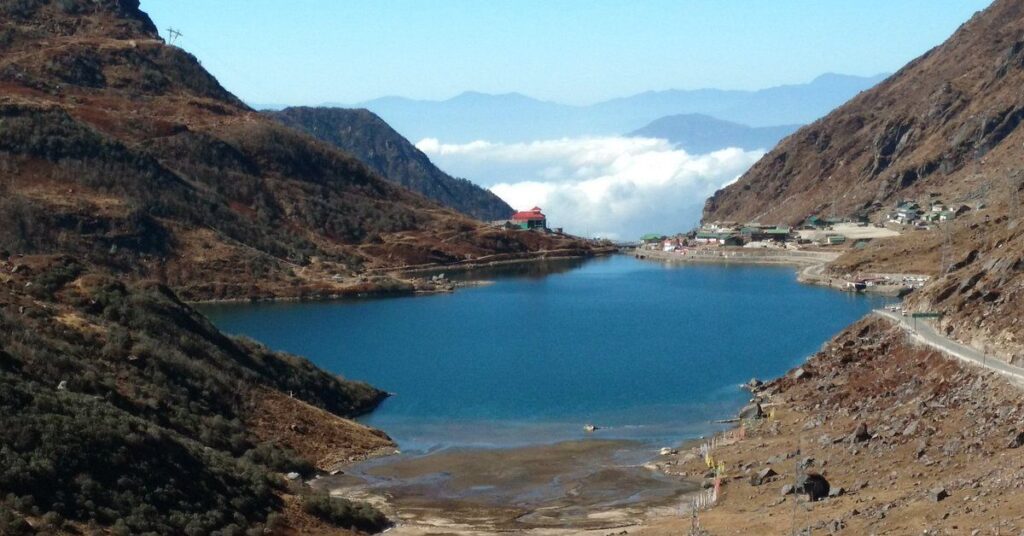
Tsomgo Lake, or Changu Lake as it’s also known, stands as a captivating gem in the crown of the region. Perched at a staggering 3,753 meters, this glacial wonder unfolds a panorama of unparalleled beauty. Imagine a crystal-clear lake, stretching roughly a kilometer in length and plunging 50 meters deep. Its mirror-like surface reflects the majestic snow-capped peaks that cradle it, creating an atmosphere of serenity that borders on the surreal.
The name “Tsomgo” itself, meaning “Source of Water” in the Bhutia language, speaks volumes about the lake’s vital role in the local ecosystem and cultural significance. But Tsomgo Lake’s magic extends far beyond its form. Throughout the seasons, its colors dance like an artist’s brushstrokes.
Nearby Attractions:
Yak Rides:
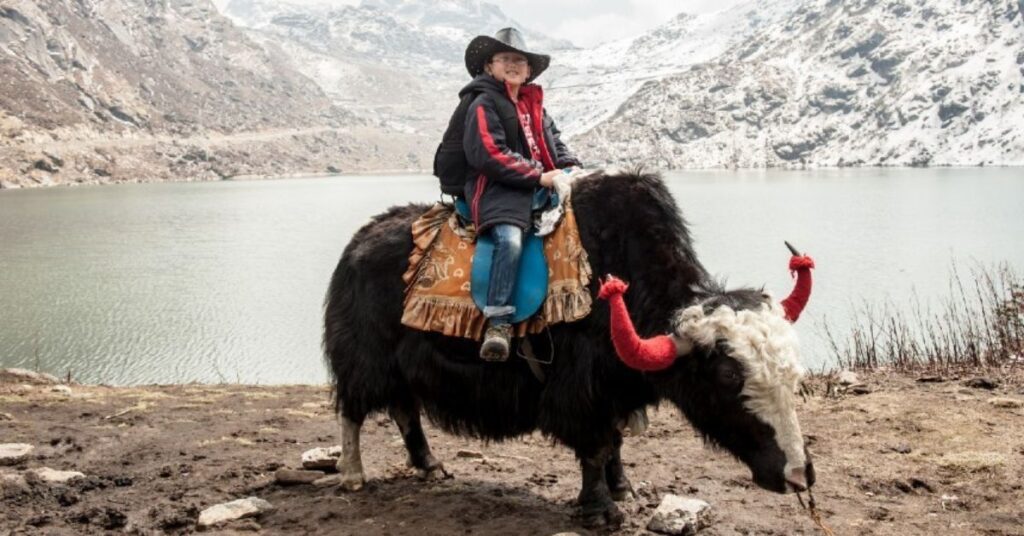
Tsomgo Lake, or Changu Lake as it’s known locally, stands as a captivating jewel in the crown of the Himalayas. Perched at a staggering 3,753 meters, this glacial wonder unfolds a panorama of unparalleled beauty. Imagine a crystal-clear lake, stretching roughly a kilometer long and plunging 50 meters deep. Its mirror-like surface reflects the majestic snow-capped peaks that cradle it, creating an atmosphere of serenity that borders on the sacred.
Baba Harbhajan Singh Temple:
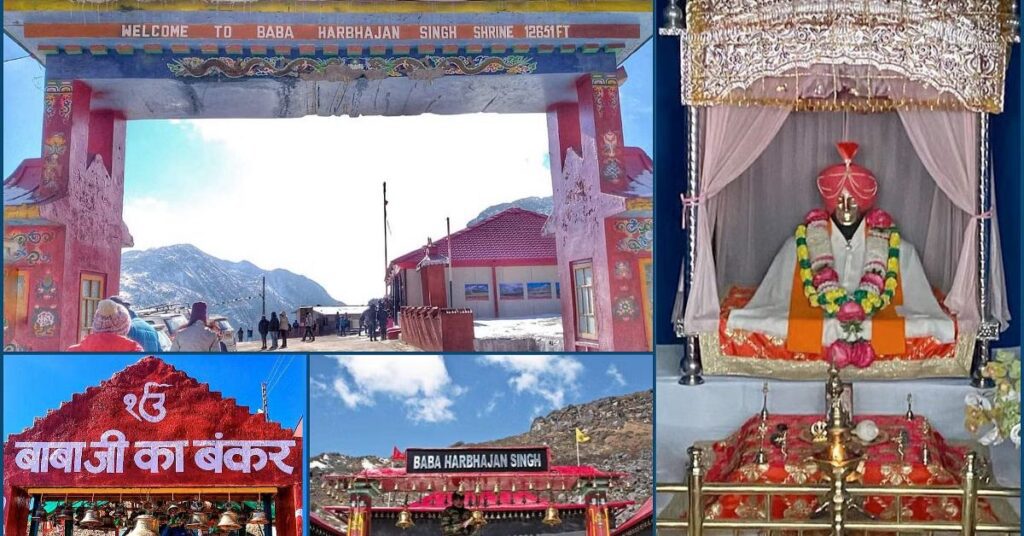
Just a few kilometers away from Tsomgo Lake lies the Baba Harbhajan Singh Temple, a revered shrine shrouded in local legend. Dedicated to an Indian Army soldier believed to be a guardian spirit, Baba Harbhajan Singh, the temple draws visitors seeking blessings and a glimpse into the region’s history.
Legend speaks of Baba Harbhajan Singh, who vanished while on duty in 1968. He is said to have reappeared in a fellow soldier’s dream, requesting a shrine in his honor. The resulting Baba Mandir, nestled amidst picturesque mountains and valleys, offers stunning vistas besides a place for quiet reflection.
Kyongnosla Alpine Sanctuary:

Shrouded in local legend, the Baba Harbhajan Singh Temple sits just a stone’s throw from Tsomgo Lake. Dedicated to a revered Indian Army soldier believed to be a guardian spirit, Baba Harbhajan Singh, the temple draws visitors seeking blessings and a window into the region’s history.
Legend tells the tale of Baba Harbhajan Singh, who vanished while on duty in 1968. He is said to have reappeared in a fellow soldier’s dream, requesting a shrine in his honor. The resulting Baba Mandir, nestled amidst picturesque mountains and valleys, offers not only stunning vistas but also a place for quiet reflection.
Nathu La Pass:
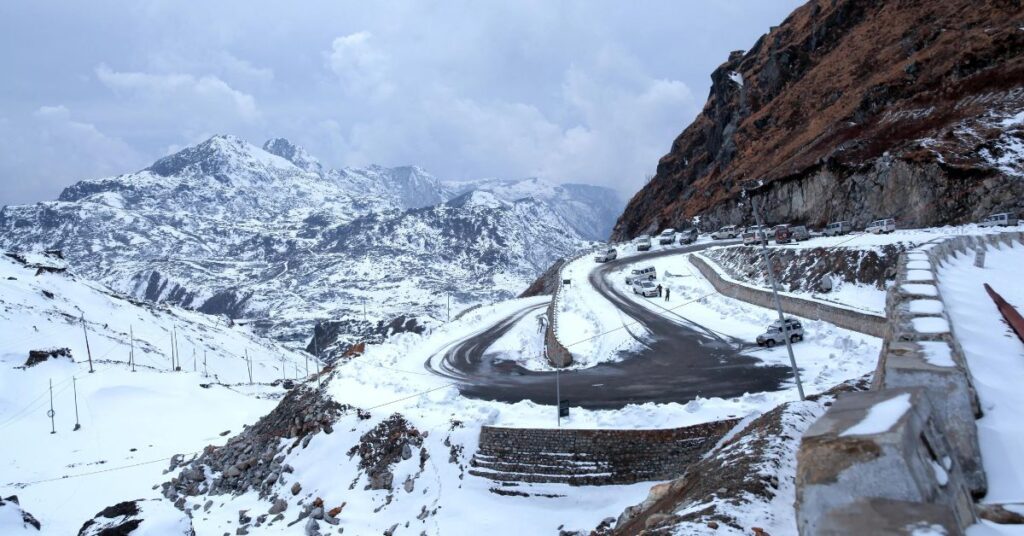
Just a 20-kilometer hop from Tsomgo Lake lies Nathu La Pass, a historic gateway connecting Sikkim to the Tibetan plateau. Perched at a staggering 4,310 meters, it’s one of the world’s highest motorable roads, offering a jaw-dropping panorama of Himalayan peaks and valleys.
Nathu La, which translates to “Listening Ears Pass” in Tibetan, has served as a vital trade route for centuries, whispering tales of its rich history and strategic significance. Open to Indian nationals with special permits, the pass beckons adventure seekers and history buffs alike.
Local Experiences:
Immerse Yourself in Local Culture:
- Shop for Treasures: Browse local handicraft and souvenir shops for intricately woven woolens, handcrafted jewelry, and traditional masks. Discover local delicacies and unique artifacts to take a piece of Sikkim home.
- Savor Local Flavors: Indulge in traditional Sikkimese dishes like momos, thukpa, and churpi at small eateries and food stalls around the lake. Savor the distinct flavors of local ingredients and spices.
Capture Unforgettable Memories:
- Embrace the Beauty: Capture the lake’s stunning landscapes and ever-changing colors. Photograph the vibrant blooms and snow-capped surroundings, documenting your unique experiences.
Explore the Natural Splendor:
- Lakeside Tranquility: Stroll along the serene shores of Tsomgo Lake, soaking in the tranquil atmosphere. Explore nearby trails and discover hidden pockets of natural beauty.
- Avian Encounters: Enjoy the serene environment while spotting a variety of bird species, including migratory birds. Bring binoculars for a closer look at the region’s diverse avian life.
Travel tips:
Essential Permits:
- Domestic Visitors: Secure permits beforehand from the Sikkim Tourism Office in Gangtok or authorized travel agents.
- International Travelers: Obtain a Restricted Area Permit (RAP) through registered travel agencies. Bring multiple passport-sized photos and a valid ID for the process.
Weather and Clothing Considerations:
- Pack for chilly weather, especially during winter. Dress in layers with thermals, jackets, gloves, and woolen hats.
- Summer and autumn require comfortable, layered clothing for fluctuating temperatures. Sturdy, waterproof shoes are a must for navigating the lake and surrounding areas.
Health and Altitude Management:
- Tsomgo Lake’s high altitude (3,753 meters) can cause altitude sickness for some visitors. Take it slow, stay hydrated, and avoid strenuous activity on arrival.
- Consult a doctor beforehand if you have pre-existing health conditions. Carry necessary medication, including altitude sickness remedies.
Transportation:
- Hire a reliable taxi or book a shared vehicle from Gangtok, ensuring it’s suitable for mountainous terrain.
- Consider a local driver familiar with the route, as weather conditions can be unpredictable and roads challenging.
Choosing the Best Time to Visit:
- April to June and October to December offer pleasant weather and easy accessibility.
- Winter visits (January to March) require checking road conditions due to snowfall. Avoid the monsoon season (July to September) with heavy rains and potential landslides.
Respecting Local Customs:
- Dress modestly and seek permission before photographing locals or their property.
- Be an eco-friendly traveler; avoid littering and follow guidelines to protect the area’s natural beauty.
Food and Water:
- Pack snacks and bottled water, especially if you have dietary restrictions. Food options may be limited around the lake.
- While trying local cuisine is encouraged, ensure fresh preparation and bottled or filtered water.
Emergency Preparedness:
- Keep a list of emergency contacts, including local authorities, your hotel, and your travel agent.
- Charge your mobile phone and consider a portable charger, as reception may be limited in some areas.
Conclusion
Dreaming of Tsomgo Lake? Xplro.com can help! Secure permits beforehand (domestic via Sikkim Tourism or agents, international through travel agencies with ID and photos). Pack warm layers and sturdy shoes for the high altitude (3,753 meters). Consider consulting a doctor if needed. April-June and October-December offer the best weather, while winter (January-March) requires road checks and avoid the monsoon season (July-September). Be respectful: dress modestly, ask permission for photos, and embrace eco-friendly practices. Pack snacks and bottled water, but savor the local cuisine (prioritize fresh prep and safe water). Stay prepared with emergency contacts, a charged phone (consider a portable charger), and enough cash for limited ATM/card access. Finally, choose responsible tourism – respect the environment and local culture. Explore more with Xplro.com to craft your perfect Himalayan getaway!
FAQs
When is the best time to visit Tsomgo Lake?
- The best times to visit Tsomgo Lake are from April to June and from October to December, when the weather is most pleasant and the lake is easily accessible.
How can I obtain a permit to visit Tsomgo Lake?
- Indian nationals can obtain permits from the Sikkim Tourism Office in Gangtok or through authorized travel agents. Foreign nationals need a Restricted Area Permit (RAP) obtained through registered travel agents.
What is the altitude of Tsomgo Lake, and how can I prevent altitude sickness?
- Tsomgo Lake is located at an altitude of 3,753 meters (12,313 feet). To prevent altitude sickness, visitors are advised to stay hydrated, rest adequately upon arrival, and consider medications like acetazolamide if prescribed by a healthcare provider.
What clothing should I pack for a visit to Tsomgo Lake?
- It is advisable to pack warm clothing such as layers, thermal wear, jackets, gloves, and sturdy shoes, especially during winter months when temperatures can drop significantly.
Is it safe to visit Tsomgo Lake during the monsoon season?
- Visiting Tsomgo Lake during the monsoon season, typically from July to September, is not recommended due to heavy rainfall, landslides, and potential road closures which can affect travel plans and safety.
What are some popular local experiences at Tsomgo Lake?
- Visitors can enjoy yak rides around the lake, visit the revered Baba Harbhajan Singh Temple nearby, explore the Kyongnosla Alpine Sanctuary with its diverse flora and fauna, shop for local handicrafts, and indulge in traditional Sikkimese cuisine at nearby stalls.
Is Tsomgo Lake suitable for visiting with children?
- Yes, Tsomgo Lake is generally safe for children to visit. Families should ensure children are properly dressed for cold weather, stay hydrated, and engage in activities suitable for their age, such as gentle walks and cultural visits.
What food and accommodation options are available near Tsomgo Lake?
- While there are food stalls offering local cuisine around Tsomgo Lake, accommodation options are limited nearby. Most visitors choose to stay in Gangtok, the capital city of Sikkim, and make day trips to Tsomgo Lake.
What should I do in case of an emergency at Tsomgo Lake?
- It is recommended to carry emergency contacts, including local authorities, your hotel in Gangtok, and your travel agent. Due to limited mobile network coverage in the area, ensure your phone is fully charged and consider bringing a portable charger.
Can I visit Nathu La Pass from Tsomgo Lake?
- Yes, visitors can journey approximately 20 kilometers from Tsomgo Lake to Nathu La Pass, a historic mountain pass connecting Sikkim with Tibet. A special permit is required for Indian nationals, and visitors should check current road conditions and weather forecasts before planning their visit.
What wildlife can I expect to see in the Kyongnosla Alpine Sanctuary?
- The Kyongnosla Alpine Sanctuary is home to various species including red pandas, Himalayan black bears, snow leopards, musk deer, and a wide array of bird species, making it a popular destination for wildlife enthusiasts and nature lovers.
Is there mobile network coverage at Tsomgo Lake?
- Mobile network coverage at Tsomgo Lake and its surrounding areas can be limited or unreliable. Visitors should inform their contacts of their travel plans in advance and consider carrying a portable charger to ensure they stay connected in case of emergencies.




